Learn to expand your photographic talents by venturing into new subjects – photo journalism.
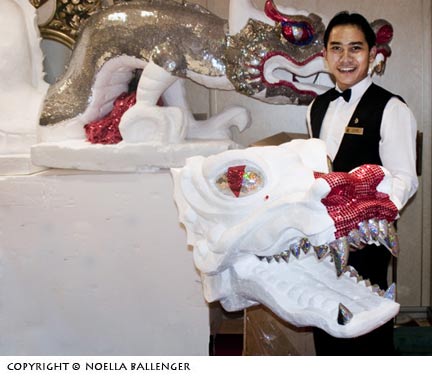
Lelik is standing in front of a dragon he carved while holding the head of another one. The decorating team artists use large Styrofoam blocks to carve some of the decorations.
As creative artists, we need to stay open and ready for the unexpected. Last year, I was on the ship MS Amsterdam as it cruised around Cape Horn from Santiago, Chile to Rio de Janerio, Brazil. I tried to prepare myself for new experiences, but sometimes special opportunities sneak up on you. I got lucky and found one.
As I’ve mentioned in the past, my photographic passion is nature. Working with people has always been a challenge–one that I tended to avoid. But once I managed to get out of myself and look at what I was doing as a chance to expand my horizons and skills, seeing the possibilities in the people around me seemed easier. Taking a cruise is like being in a fine hotel surrounded by beautiful décor and friendly staff. On a longer cruise, you often move past the superficial and learn about the individuals, their homes, their backgrounds, their families and dreams. Such was the case for me and a wonderful young man named Iwayan “Lelik” Purnawan.
Lelik was a part of the dining room staff in the evenings, but he was also a part of the decoration team for the ship. He has a maternal grandfather in Indonesia who is a wood carver, the source of Lelik’s artistic talent. Grandfather carves elaborately embellished doors, since there is now a large demand for those products. When Lelik was ten years old, his grandfather pushed him into art school. By the end of first month, Lelik decided he liked to learn. He was able to earn enough money for a bicycle from his artwork, so he continued his studies.
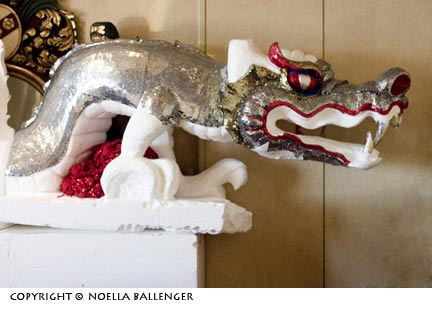
The decorations are frequently quite large but need to be lightweight, festive and exciting. Passengers were excited as almost every evening, the decorations changed. Big pieces such as the dragon are stored for use on the many trips the ship takes each season.
When Lelik was sixteen, his uncle–who was already working on world cruises–took him on the MS Rotterdam to show him around. Lelik was really impressed when his uncle told him about the wonderful places he had seen and how fun it was to go around the world at “no cost.” When he finished high school, Lelik decided to go into hotel management, and for two years he worked for the Ritz Carlton Hotels to learn budget and management. By the time he was twenty-two (three years ago), Lelik became a part of the crew of the Holland American line. However, it was only about three months before we met him that he began to carve. Two of his friends on the decoration team wanted him to do a carving of a red dragon out of one of the large blocks of Styrofoam they use for ship decorations. The decoration team does special displays in themes that are appropriate to special functions such as Captain’s Dinner and Indonesian Night. Their work is beautiful. Lelik did a carving for his friends and was soon reassigned to the decoration team for the Oriental cruise.
Not all photographers will have an opportunity similar to my experience with Lelik or will want to write a stories about people they meet or what they do on a family vacation, but we all feel a need to tell a story either through an individual photograph or a series. So, how does the interview process work? How do you put someone at ease in front of the camera? And what photographs do you need to take to make your “story” work?
Putting someone at ease is truly reliant on being at ease with yourself and your equipment. To capture a nice photograph of a person, you need to be really relaxed, and your attitude will carry over to your subject. You can do this best by knowing your equipment, understanding what you want to accomplish, and learning to give clear and simple instructions to your subject. Also, sharing something of yourself is helpful. For example, I told Lelik how much I enjoyed art when I took it in school and then I asked him about his tools he used and how he went about creating beautiful decorations. The more curious I became, the more he was willing and happy to share with me. After chatting with him for a few minutes, it was easy for me to ask him to stand in a certain place or to show and explain to me how he created the dragon or Buddha.
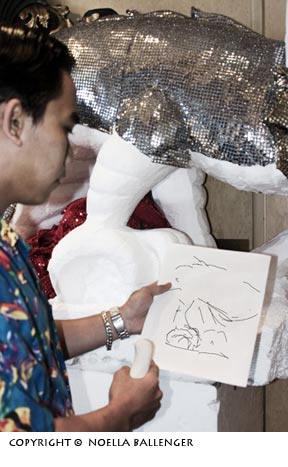
Lelik showed me how he begins his carving projects by making a sketch of what he wants to do. It is refined on the drawing until he has exactly what he wants
Keep in mind the wonderful “W’s” of journalism: who, what, where, when and why. I try to build my questions for the interview around them. They are my photographic guidelines, as well. If you can picture in your mind the kind of presentation you want to make with your photographs, then it’s much easier to work, because you have a flexible plan. When I’m photographing specifically for a story, I can picture the images or the progression of images I want to show. I know I want to get overall shots. These images have to capture the viewers and make them interested enough to want to see more. Then I need to have detail shots. These have to tell the viewers what’s happening or the details of the object I’m shooting. Finally, I always try to do a couple of “artistic” shots–perhaps something with unusual lighting or a different angle. When I merge the variety of images together, I get a much more interesting presentation, because the underlying structure is sound.
It’s not always easy to push yourself into being a “different” kind of photographer from usual, but it’s a growth experience. I learned quite a bit about myself while doing this self-assignment. I know that if I want my photography to keep getting better, I need to grab different opportunities that come along and make them my own. I need to give myself more assignments that involve people, because shooting them doesn’t feel as comfortable for me as it should. I also need to think in broader terms than just one photograph. I need to think of each photograph as fitting into a special place in a large program. Each piece will tell one part of the story. Together, they’ll weave a wonderful presentation that will capture my viewers.
Would I recommend taking chances and pushing yourself into other kinds of photography than you ordinarily do? You bet. If you love doing people photography, go to a park or garden and do some nature work. If landscapes are your thing, then go to the zoo and tell the story of an animal. Whatever your passion is, change gears and do something entirely different–just to see what you will do. Make it a fun assignment. Certainly relax and try it. You’ll probably learn about yourself and your subject, and you’ll end up with images that will delight you and your viewers.
How do you interview? What photographs do you need to make your story work? Feel as though you are making a friend.
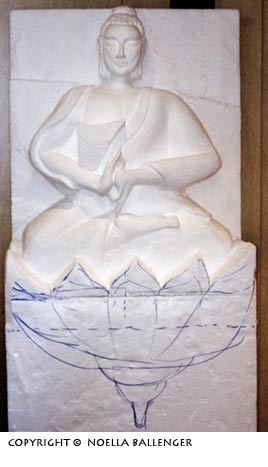
The sketch is roughly drawn on the big block of Styrofoam and it may be refined even more at this stage. This is the really big and beautiful Buddha that he was still carving.
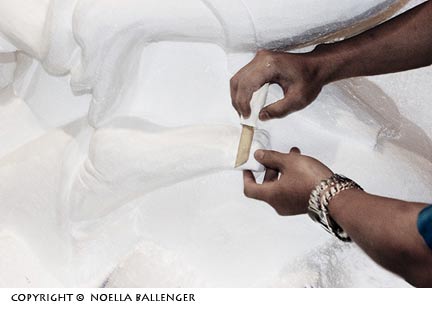
After Lelik is satisfied with the sketch on the Styrofoam he begins to carve. He uses an assortment of very sharp knives to cut and carve the object. He occasionally uses a fine sand paper to smooth out the edges of the carving.
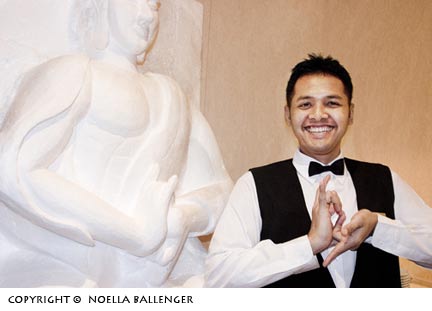
Sometimes Lelik asks a friend to help him with the details. Checking the sketch and carving of the Buddha’s hands against his friend holding the same hand position helps make the carving come to life.
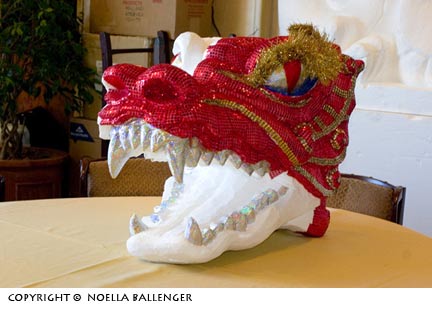
When the carving is finally finished, it may be decorated with paint or exquisite paper or fabric and trimmings. Frequently when they visit unusual ports of call, the decorating team will go shopping to find some of the unusual “finishing touches” for their displays.
by Noella Ballenger

Leave a Reply